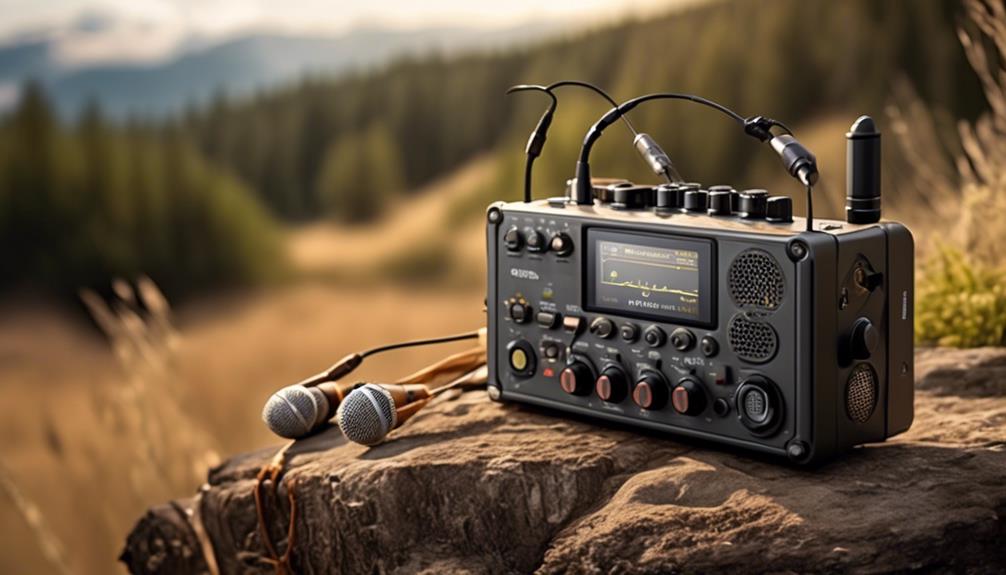As creators, we are always striving to capture and communicate the essence of our environment, whether it be the peacefulness of a natural landscape or the dynamic energy of a live concert.
But how can we authentically preserve these auditory moments in their purest form, free from the constraints of a traditional recording studio?
This is where the field audio recorder comes into play, offering a solution that empowers us to capture high-quality audio in the most dynamic and remote environments.
But what exactly sets these devices apart, and how can they enhance our creative endeavors?
Let's explore the intricacies of field audio recorders and uncover their significance in the realm of sound capture.
Key Takeaways
- Field audio recorders are portable devices designed to capture high-quality audio recordings in non-studio environments.
- They are essential for capturing authentic and high-fidelity sounds outside of traditional studios, adding depth and realism to audio productions.
- Field audio recorders provide features like adjustable gain levels, 24-bit WAV recording, and wind protection accessories to ensure high-quality sound capture.
- Different types of field audio recorders cater to different recording needs, making them suitable for various applications such as nature recordings, sound effects for media production, and music production.
Definition of Field Audio Recorder
A field audio recorder is a portable device specifically designed for capturing high-quality audio recordings in non-studio environments. These portable digital recording devices are crucial for field recording, enabling sound designers to capture natural sounds, sound effects, voice, and music in diverse settings. Handheld field recorders and multi-track recorders with XLR inputs are common forms of field audio recorders. They offer features such as high-quality preamps and 24-bit/96kHz recording, ensuring exceptional audio fidelity. Additionally, field audio recorders often come equipped with wind protection, shock mounts, and various microphone options to facilitate superior recordings in challenging field recording scenarios.
One of the critical aspects of a field audio recorder is its ability to capture sound at a high sample rate, which contributes to the production of high-quality audio. This is particularly important when recording delicate sounds, such as those found in nature, to preserve their authenticity and depth. As sound designers, we rely on field audio recorders to accurately capture the sonic environment, enabling us to create impactful soundscapes and effects for various audiovisual productions.
Features of Field Audio Recorders

Field audio recorders provide an array of essential features for capturing high-quality sound in diverse environments. These devices often come with built-in microphones and additional XLR inputs for external microphone use, providing flexibility in recording options. They also offer adjustable gain levels, 24-bit WAV recording, and various sample rates to ensure high-quality sound capture.
Additionally, wind protection accessories such as windshields and blimps are commonly used with field audio recorders to nullify wind noise and provide superior isolation, enhancing the overall sound quality.
Field audio recorders are crucial for various applications such as nature recordings, sound effects for media production, research in bioacoustics, and music production. These features make field audio recorders indispensable tools for professionals seeking to capture pristine sound in diverse and challenging field recording environments.
Types of Field Audio Recorders
When considering types of field audio recorders, it's essential to evaluate the specific recording needs and technical requirements to determine the most suitable device.
Field audio recorders come in various types, each designed to address different recording scenarios. Portable handheld recorders, such as the Zoom H1n, are ideal for on-the-go field recording, offering convenience and ease of use.
Multi-track recorders, like the Zoom F6, provide more advanced features, multiple inputs, and high-resolution recording capabilities, making them suitable for capturing complex soundscapes and multi-source audio environments.
Another popular choice is the Sound Devices MixPre series, known for its high-quality preamps, versatility, and durability. These recorders often feature XLR inputs, enabling the use of professional microphones to create a realistic and immersive sound experience.
Whether it's the first field recording or a seasoned professional looking for a good upgrade, the diverse range of field audio recorders ensures that there's a suitable option for every field recording need.
Importance of Field Audio Recorders

Essential for capturing high-quality audio recordings outside of traditional studios, field audio recorders are indispensable tools for a wide range of audio production purposes. The importance of field audio recorders lies in their ability to capture authentic and high-fidelity sounds that add depth and realism to audio productions.
Here's why field audio recorders are crucial:
- Creativity: Field audio recorders enable capturing unique and organic sounds that can elevate the creative aspects of audio production, allowing for the creation of immersive and realistic auditory experiences.
- Realism: They're essential for capturing ambient sounds, transient noises, and environmental textures, adding depth and realism to audio projects. This is particularly important in film, music, and game production where authenticity is key.
- Wind Noise and Acoustically Treated Environments: Field audio recorders are crucial for overcoming challenges such as wind noise and capturing sounds in acoustically treated environments, ensuring that the recorded sounds are of the highest quality and free from unwanted disturbances.
Tips for Using Field Audio Recorders
Capturing high-quality audio recordings outside of traditional studios requires careful consideration and specialized equipment, making it essential to understand the best practices for utilizing field audio recorders effectively.
When engaging in field recording, it's vital to make strategic preparations. This includes scouting the location, understanding the environmental conditions, and planning for any potential challenges that may arise.
Once on-site, the crew should set gain levels appropriately to avoid distortion or noise issues. Patience is crucial, as capturing the perfect sound often requires waiting for the right moment.
Selecting the right microphone for the specific environment is essential for mimicking realistic audio quality. When using digital field audio recorders, it's important to take advantage of the available features for adjusting settings to achieve optimal results.
Furthermore, it's crucial to make use of wind protection options such as windshields and blimps to minimize unwanted noise interference from wind.
Frequently Asked Questions
What Is the Purpose of a Field Recorder?
The purpose of a field recorder is to capture high-quality audio in outdoor or uncontrolled environments. It's essential for:
- Outdoor interviews
- Nature sounds
- On location podcasts
- Wildlife recording
- Concert recordings
- Environmental soundscapes
- Remote audio capture
- Travel vlogging
- Documentary audio
- Outdoor music festivals
Field recorders come with features like built-in stereo mics and versatile mounting options, providing the necessary tools for capturing professional-grade audio in diverse outdoor settings.
What Is the Difference Between Field Recording and Studio Recording?
Field recording captures the raw audio of live performances and natural soundscapes in outdoor environments, unlike studio recording, which occurs in controlled settings.
It's all about mobile recording on location, providing a real-world perspective and catering to the challenges of remote locations.
Field recording offers a unique approach to capturing sound, inspiring creativity and delivering high-quality audio independently of a camera.
What Is the Difference Between a Camera and a Field Recorder?
When comparing a field recorder to a camera, the key difference lies in their primary function. While cameras capture video and images, field recorders focus solely on capturing high-quality audio.
Field recorders offer professional-grade audio quality, portability, and features like sound isolation, external microphone support, and audio monitoring. They're essential for on-location recording and are integral to field recording techniques, particularly in video production outside controlled environments.
Do I Need a Field Recorder?
Yes, we need a field recorder for its superior audio quality, portability options, and equipment compatibility in various environmental conditions.
It allows us to employ field recording techniques efficiently in remote locations, ensuring sound isolation and backup solutions.
Additionally, it minimizes noise interference, offering numerous benefits for capturing high-quality audio.
Conclusion
In conclusion, field audio recorders are indispensable tools for capturing the rich and immersive sounds of the world around us.
With their portable and high-quality recording capabilities, they allow us to capture the subtle nuances and ambient sounds that bring our projects to life.
Whether capturing the rustling of leaves in a forest, the roar of waves on the beach, or the lively chatter of a bustling city, field audio recorders help us preserve and share the beauty of sound.










